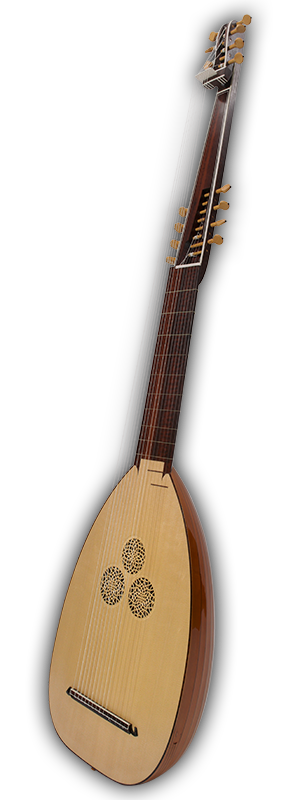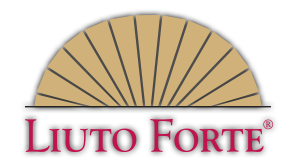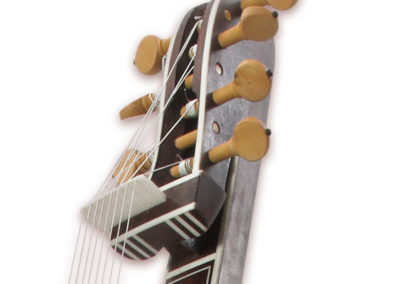Tiorba forte in a
(Roman Theorbo or “Chitarrone”)
Repertory: all compositions for theorbo of the 17th to 18th century, continuo, music of the 19th to 21st century
14-stringed: G A B C D E F G A d g b e a
- String-length fingerboard strings 80 cm, bourdon strings 120 cm
- (other String-lengths by arrangement)
- a’ = 415 or 440 Hz
- Single stringing
- Slightly curved fingerboard
- 14 fixed frets (tied-on if desired)
- Veneer extension inlaid edges
- Triple rose, 19 ribs
- Traditional or geared pegs
- Wood: Rosewood, Maple, Yew
(recommended for predominant use in continuo: Maple or Rosewood; for solo repertoire also Yew.)

Liuti forti are delivered directly from the manufacturer and are not available from music shops.
If you would like to order a Liuto forte or need advice please send us an email.
If you wish, we can also put you in touch with Liuto-forte players in your area.
Continuo instruments are in a position to profit especially from the advantages of the Liuto forte soundboard construction. The Tiorba forte is not so large, yet packs power with its 4 to 5.5 kg tension per string which even the much larger historically constructed continuo instruments cannot match, not to mention their airline incompatibility. Not only the reduced string length, but in particular its warm, rich tone also suit the Tiorba forte for the rendition of solo theorbo repertoire.
The theorbo was developed shortly after Alessandro Piccinini’s (1566 – 1639) invention of the arciliuto around 1600 from the great octave bass lute. This was the largest instrument of the 16th century family of lute instruments consisting of descant lutes in b natural or c, alto lutes in g or a, tenor lutes in e, bass lutes in d and octave bass lutes in g, all of which were angled neck lutes. Octave bass lutes had 6-8 choirs and scales between 88 and 94 cm. Their tuning was the same as that of the small alto lutes in g, but an octave lower.
Due to their enormous air resonance, octave bass lutes were increasingly discovered as accompanying instruments for singers at the beginning of the age of monody. However, since their tuning was clearly too low for this, the idea came up to bring them, despite their enormous string lengths, into the more suitable, higher pitch of the alto lute (in this case A d g b e’ a’), which required a compromise:
Because no string material in the world would have allowed the tones e’ and a’ of the two highest strings of an alto lute in a to be realized on a scale of 88-94 cm, these two strings were simply tuned an octave lower:
A d g b e a
The instrument with 6, 7 or 8 string choirs and without extended bass strings was no longer called the octave bass lute but – probably because of its re-entrant tuning – “chitarrone”, as inventories from the end of the 16th century show.
In the foreword to one of his lute books, Piccinini describes how the attachment of the extension he invented for his Arciliuto with the additional bass strings to the Chitarrone made this originally unpopular accompanying instrument into the spectacular type of lute that soon became famous as “Tiorba” or “Theorbe” and soon enjoyed great popularity.
This instrument – still called the Chitarrone by many – had six double or single strings on the fingerboard and 8 to 10 extended, diatonic tuned basses. His most common tuning was
G’ A’ B’ C D E F G A d g b e a
Not only did it perform excellently as a basso continuo instrument in the orchestra, it was also quickly discovered by the virtuosos, who created a highly attractive solo repertoire for it.
It is always astonishing that the theorbo tuned in A d g b e a does not cause many more guitarists to turn to this instrument in addition to their guitar. Each of its fingerboard strings is already familiar to the guitarist and would open up tempting possibilities beyond the guitar. Even if the handling of the additional eight bass strings and the learning of the basso continuo may take a certain amount of time, this effort is nevertheless extremely rewarding in view of the resulting possibility of participating in performances of important works of the 17th and 18th centuries.
In the 17th and 18th centuries, theorbos were also built in smaller sizes and used in tunings other than the standard tuning given here.
“Sylvius Leopold Weiß, for example, tuned his theorbo as follows:
F’ G’ A’ B-flat’ C D E F G A d f a d’
The tuning of the first five strings was identical to the tuning of the second to sixth strings of his D minor lute. This avoided a fundamental rethinking when he had to switch from one instrument to the other”.
Samples
Please note that when recording with Liuti forti, there is no difference between the sound of the instrument in the recording and the sound of the instrument in the original. If you wish, compare the sound of the respective pieces with recordings of the same piece on copies of historical lutes that can be found on the Internet.
Hieronymus Kapsberger
„Preludio e Toccata seconda“
Mauro Pinciaroli, Guitarist, Italy
Tiorba forte in a (440 Hz), Maple, played with nails





